About Balance
What is in Balance?
To be ‘in Balance’ is to be physically centered in all you do, your weight balanced front to back and side to side, with alignment of the spine and major joints. Balance allows your bones to carry weight and leaves your muscles relaxed and ready for action.
Aren't we naturally in Balance?
We all began life in balance; every healthy child is born in alignment.
But industrialization and sedentary lifestyles have altered our habits, undermining the alignment and ease we were born with. And we continue to adapt to the changing demands of today's workplace: 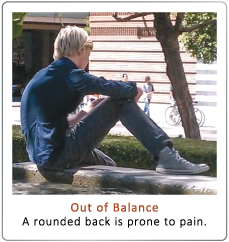 less physical activity, more desk work, and more time in our cars, commuting. We often accept discomfort, hardly aware of it. Computer screens invite craned necks and keyboards hurt our wrists. We adapt until we get hurt. Depending on how you stand or sit, you are either in a state of struggle or in a state of ease, either in conflict with gravity or in harmony with it.
less physical activity, more desk work, and more time in our cars, commuting. We often accept discomfort, hardly aware of it. Computer screens invite craned necks and keyboards hurt our wrists. We adapt until we get hurt. Depending on how you stand or sit, you are either in a state of struggle or in a state of ease, either in conflict with gravity or in harmony with it.
When a person is in Balance, there is no friction, no resistance to gravity. There is only ease. Balance enables people to be comfortable, pain-free, resilient, and graceful at any age. It provides a foundation for any activity - sitting, standing, and lying down, playing a musical instrument, dancing, gardening, or engaging in sports - whatever you do. Balance is true fitness.
Benefits
Small changes will quickly make a big difference in how you feel.
- Pain relief:
As you begin to undo stiffness and strain, your pain will diminish or dissolve altogether. You may reduce or eliminate low back pain, neck and shoulder pain, hip, knee or foot pain, sciatica. You may reduce the effects of scoliosis.
- Fitness:
Discover a fitness that is not based on muscle strength, but on increased bone support and balanced muscle tone.
- Posture:
With practice, your body reshapes itself in a postural expression that is natural to you. The emphasis is not on good or bad posture, but on centering yourself along the gravity line.
- Exercise:
Ordinary activities replace the gym. Sitting at your desk, bending to unload the dishwasher, walking, standing in line, all become opportunities for practice. There is no need to buy expensive chairs or exercise equipment.
- Empowerment:
Balance gives you a foundation for self-care. You will learn how to prevent injury and participate safely in activities you enjoy, such as biking, dancing, golf, yoga, walking and exercise. You will find that you can do these activities longer, without tiring or getting sore.
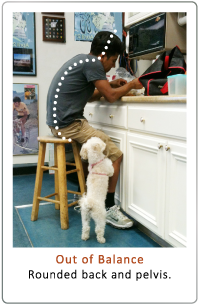
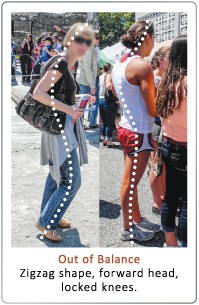

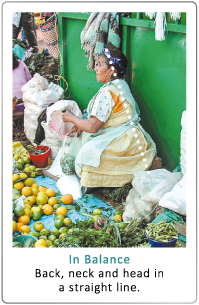
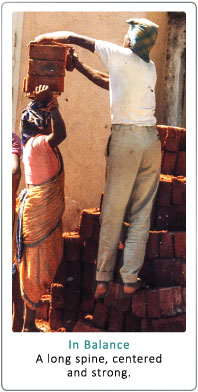
How is Balance learned?
The Balance technique teaches basic principles that underlie all positions and movement. Ordinary activities will become both practice and therapy. Every action becomes an opportunity to strengthen, lengthen and stretch.
The history of Balance.
Balance is based on the revolutionary insights of Noëlle Perez-Christiaens, who has been in tireless pursuit of physical ease and lightness since 1959. She experienced a taste of this as a yoga teacher studying in India with yoga master BKS Iyengar. Moments of exquisite lightness made her believe that ease was possible, yet pain kept her from achieving it consistently in yoga or in daily life. What was missing?
This question set her on a path of inquiry, first in India, then Africa and finally Europe. In Portugal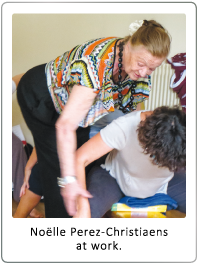 she found what she was looking for: a group of workers who carried on their heads the heavy loads of fish moved from ship to shore, while walking a narrow gang plank. She was impressed by the energy, strength and youthful bearing of these men and asked for permission to study them.
she found what she was looking for: a group of workers who carried on their heads the heavy loads of fish moved from ship to shore, while walking a narrow gang plank. She was impressed by the energy, strength and youthful bearing of these men and asked for permission to study them.
Her subsequent empirical research and anthropological studies led to the conclusion that the upward thrust of gravity was the key to their strength and endurance. She found other people with the same grace and ease as the Portuguese longshoremen.
They all became her “teachers”.
Teaching others what she learned became her life’s work. She called it APLOMB and to carry out her mission she created the Aplomb Institute in Paris, France. Inspired by her work, Jean Couch of Palo Alto, CA established the Balance Center in 1992 to teach Aplomb under the name of Balance and to train teachers.

